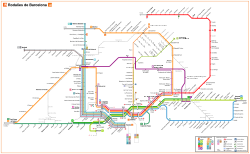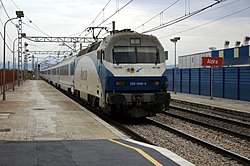This article needs additional citations for verification .(November 2015) |
| Catalonia | |||||
|---|---|---|---|---|---|
 An FGC 113 series at Valldoreix station | |||||
| Operation | |||||
| National railway | FGC | ||||
| Infrastructure company | Ifercat and Adif | ||||
| Major operators | FGC, Renfe, Ouigo and Iryo | ||||
| Statistics | |||||
| Ridership | 235.7 million (Generalitat de Catalunya, 2019) [1] | ||||
| Freight | 6.8 million tons per year (Generalitat de Catalunya, 2019) [1] | ||||
| System length | |||||
| Total | Total 1,865 km (1,159 mi), FGC 297 km (185 mi), [1] Renfe 1,568 km (974 mi) [2] | ||||
| Features | |||||
| No. stations | 316 (110 served by FGC and 206 served by Renfe) [1] | ||||
| |||||
Rail transport in Catalonia operates on three rail gauges and services are operated by a variety of public operators: [3]
Contents
- Transport authorities
- Rodalies de Barcelona
- Rodalies de Girona
- Rodalies de Lleida
- Rodalies de Tarragona
- Mitjana distància and Regional Exprés
- Llarga distància
- Alta Velocidad Española
- Railway gauge
- Metropolitan railways
- Territory
- References
- Ferrocarrils de la Generalitat de Catalunya lines (FGC):
- Broad gauge lines (Renfe):
- Rodalies Barcelona lines
- Regional lines (Mitjana distància in Catalan)
- Long-distance lines (Llarga distància)
- Transports Metropolitans de Barcelona lines (TMB):
- Tramway lines:
- Tramvia Blau (TMB)
- Tram lines (TRAM)
- High speed lines in Catalonia (Renfe)
- AVE lines (in Standard gauge)
- High speed trains (in broad gauge)
- Funicular and aerial tramway of Catalonia ( Funiculars i telefèrics de Catalunya )













